Types of anesthesia for liposuction in Iran, using medications, allow medical procedures to be performed painlessly and in some cases on the patient’s consciousness. Anesthesia medications are used in many ways, from highly invasive surgeries, such as open heart surgery, to minor procedures such as tooth extraction. There are four types of anesthesia: general, regional, local, and supervised. The types of anesthesia commonly used depend on the type of surgery, the patient’s health status, the duration of surgery, and the preferences of the anesthesiologist and surgeon.

General anesthesia for liposuction in Iran
General anesthesia is what people think of when they hear the word “anesthesia.” During general anesthesia, the patient is anesthetized and has no consciousness or sensation.
Many various medicines may be used during general anesthesia. Some are anesthetic gases or vapors that are prescribed through a breathing tube or mask.
Some medications are injected through IV to stimulate sleep, relax muscles, and alleviate ache. In this case, the patient is anesthetized for a short time.
General anesthesia also paralyzes the patient’s muscles. Accordingly, the patient needs air conditioning or oxygen. Anesthesia staff continuously monitor the patient’s vital signs such as heart rate, blood pressure, and respiration during surgery. After surgery, other drugs are used to reverse the effects of anesthesia.
General anesthesia is the strongest type of anesthesia and is mostly used for unbearable and painful surgeries such as knee replacement and heart surgery.
It is also used in certain situations where the patient may not be able to cooperate with the doctor during surgery, such as surgery for children who need a myringotomy (ear tubes).
The most common modern general anesthetics today are a mixture of inhaled gases, including nitrous oxide and various ether derivatives such as isoflurane, sevoflurane, and desflurane.
General anesthesia will relax the muscles in the gastrointestinal tract and airways that prevent food and acid from passing from the stomach to the lungs.
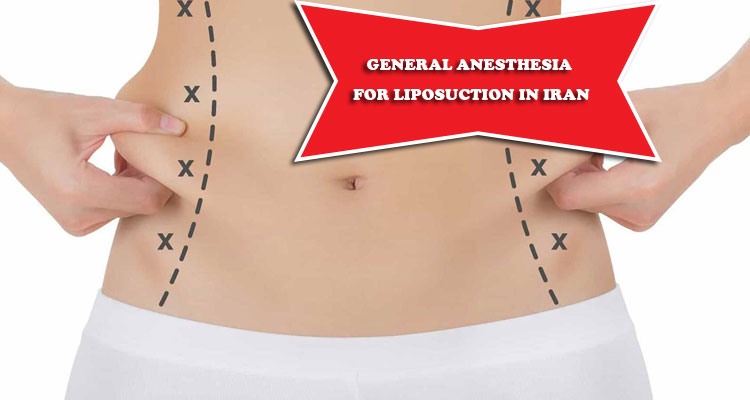
General anesthesia instructions for liposuction in Iran
Always follow your doctor’s instructions for avoiding food and drink before surgery. Fasting is usually required about six hours before anesthesia.
You may be able to drink clear liquids for a few hours beforehand. Your doctor may tell you to take some of your usual medications with a small sip of water throughout your day.
related article: Cost effective Liposuction in Iran!
You may need to stop taking certain medications, such as aspirin and some over-the-counter blood thinners, at least a week before your operation. These drugs may cause side effects during surgery.

Regional anesthesia
Regional anesthesia is performed by injecting an anesthetic with a needle or catheter. This method numbs only specific parts of the body on which the surgery is performed.
The patient is still conscious during the surgery, but anesthesia affects the nerves and causes numbness at the injection site.
The two most frequently used types of regional anesthesia are spinal and epidural anesthesia. Both methods may be used for childbirth or for orthopedic surgeries such as knee and complete hip replacement.
Epidurals
Epidurals (spinal block) in which the drug is injected behind the patient’s back are an example of regional anesthesia. The drug is transferred to the spinal cord fluid through a tiny needle into the spinal sac.
Epidurals have no side effects. Spinal blocks have many uses and are used to prevent pain in the arms and legs during surgery on this organ.
They are also commonly used during childbirth to limit the use of painkillers in one area of the body. Another example of regional anesthesia is a peripheral nerve block that may be used in the shoulder, arm, back, or leg.
Local anesthesia for liposuction in Iran
Local anesthesia blocks the nerves that connect a specific part of the body to the brain and prevents the transmission of pain signals to the brain.
Local anesthesia is a term used for drugs such as lidocaine through a needle or as a cream to numb a small area. This type of anesthesia is usually used to anesthetize a small area for minor procedures such as dental fillings or skin biopsies.
During the use of local anesthesia, an anesthetic is either applied to the skin as a cream or spray, or injected into the area where the surgery will be performed. In case of drug injection, several small injections are used.
The area should be completely anesthetized a few minutes after the injection, otherwise other methods of anesthesia will be used.
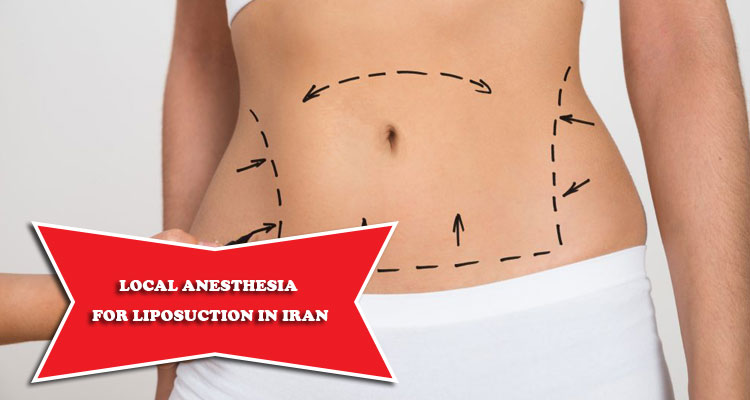
Supervised Anesthesia (MAC)
MAC is a type of analgesic commonly referred to as “twilight sleep.” MAC is usually used for outpatient procedures such as colonoscopy or cataract surgery and is performed through IV to make the patient feel sleepy and relaxe
d. This type of anesthesia is different from general anesthesia because the patient’s muscles do not become paralyzed and the patient does not need oxygen therapy. But the patient’s vital signs are still closely monitored.
The effect of this type of anesthesia disappears in 10 minutes. The amount of drug injection will vary depending on the type of operation and the patient’s preference.
In mild anesthesia, which is often used for eye surgery, the patient is awake and can answer the surgeon’s questions or instructions. In moderate sedation, the patient may regain consciousness easily.
Deep sedation is almost similar to general anesthesia, and the patient is completely anesthetized but can breathe without oxygen therapy. Deep sedation with a drug called propofol is often used in procedures such as upper endoscopy or colonoscopy.
Complications of anesthesia
Just as no surgery is safe, no type of anesthesia can be 100% safe. However, in general, as the level of anesthesia increases, the incidence of complications and risks increases.
The main complications of MAC include nausea and vomiting.
Local anesthesia can cause side effects such as pain in the numbed area and an allergic reaction to anesthesia.
Risks of regional anesthesia for liposuction in Iran include:
1.Convulsions
2.severe headache
3.Nerve damage
4.Low blood pressure
5.Difficulty urinating
6.Infection of the spine
7.Bleeding around the spine
8.Allergic reaction to the anesthetic used
Some of these side effects, such as nerve damage and seizures, are very rare, but always consult your doctor if you are concerned.
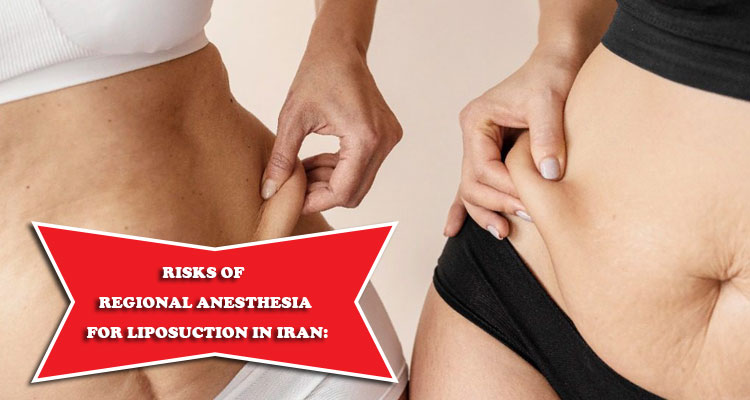
Complications of general anesthesia
The most common side effect of general anesthesia is drowsiness afterwards, which usually disappears within an hour or two after surgery. Some patients may suffer a sore throat or nausea.
If you have a history of illness or nausea after surgery, be sure to tell your doctors and nurses, as you may need medication before surgery to prevent postoperative nausea. Serious reactions to general anesthesia are very scarce.
The anesthesia team will have immediate access to emergency medication to treat any reactions and will monitor vital signs continuously during surgery and recovery. Most side effects of general anesthesia occur immediately after surgery but go away after a while.
Some usual side effects of general anesthesia for liposuction in Iran are as follow:
1.Vertigo. Dizziness after anesthesia can be relieved by drinking plenty of liquids.
2.Bladder problems. Some people have difficulty urinating for some time after general anesthesia.
3.Muscular pain. Medications used for surgery can cause pain afterwards.
4.Sore throat or bruising. Placing a tube in the patient’s throat to breathe during surgery can cause a sore throat after removal.
5.Itching. The use of narcotics during or after surgery can cause itching. Itching is a common side effect of this type of medication.
6.Feeling shivering and cold. General anesthesia can cause colds or chills in some patients, which may last from minutes to hours.
7.Dry mouth. Some patients experience dry mouth after regaining consciousness. Pouring water into the mouth can help care for dry mouth if the person does not have severe nausea.
8.Nausea and vomiting. This side effect usually occurs immediately after surgery, but in some people it may last for a day or two. Your doctor may prescribe anti-nausea medications to relieve this complication.
9.Confusion. Patients may feel dizzy and drowsy after anesthesia. Of course, this complication usually lasts only a few hours, but for some people, confusion in the elderly can last for days or weeks.
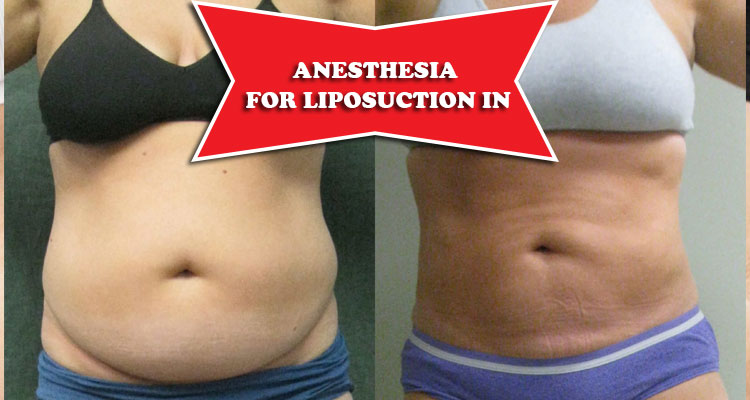
Liposuction operation and how to do it
Liposuction cosmetic surgery is performed to remove excess fat cells and repair various areas of the body such as the abdomen, thighs, buttocks, arms and so on.
Before performing cosmetic surgery, the specialist doctor begins by drawing a circle on the areas where there are excess fat cells.
It then creates nomadic swabs to perform Liposuction in Iran cosmetic surgery on the scarred areas. It then inserts a small, thin tube called a cannula into the skin through the holes.
This tube has vibrational movements, as a result of which the smooth adipose tissue is crushed and emulsified. Finally, this emulsion can be removed by suction force.
But now the question arises whether the surgeon performs local anesthesia before the operation or goes to general anesthesia? It depends on the sensitivity of the target area, the amount of fat that can be extracted, and therefore the duration of the operation. If the operation time is long, the anesthesiologist will choose.
Liposuction and anesthesia
Liposuction was first performed under general anesthesia. These initial surgeries led to extensive bleeding and bruising and a long recovery time. In the late 1980s, Dr.
Jeffrey Klein introduced a common concept in dermatology – tumescent fluid – for liposuction. This allowed surgeons to perform Liposuction in Iran using only local anesthesia, but also reduced bleeding, bruising, and overall recovery time compared to those primary procedures.
Today, “Liposuction in Iran” patients under general anesthesia or local anesthesia receive both tumescent fluid as part of their procedure.
However, there are still key differences between the methods of using each type of anesthesia and what can be done with each. Depending on your personal preferences, your specific body goals, or your budget, one type of anesthesia may be best for you.

Advantages and disadvantages of liposuction under local anesthesia
Liposuction under local anesthesia is performed by many surgeons around the world. Its main advantages are patient peace of mind (some people do not like the idea of ”going under”), less cost and less risk.
Benefits of local anesthesia
1.More relaxation – Some patients find the idea of general anesthesia distressing, and recovery from general anesthesia can be a disconcerting experience.
2.No risk of complications related to general anesthesia
3.It costs less because you do not need an anesthesiologist
4.It is not required to travel to a hospital or surgery center
4.Surgeons usually use smaller cannulas, which reduces the risk of ulcers, bleeding and bruising.
Disadvantages of local anesthesia
Liposuction surgery under local anesthesia may limit the size of the cases or the number of areas that can be performed in one procedure, both for patient comfort and because of the potential for lidocaine poisoning.
Advantages and disadvantages of liposuction under general anesthesia
Liposuction in Iran under general anesthesia is still considered by many surgeons to be the preferred method of performing liposuction – it is certainly easier for the surgeon, as they do not have to worry about ensuring that the surgical site is totally numb.
The main advantage for patients is that it allows them to do larger things in one procedure – and of course, if waking up during surgery seems scary to you, general anesthesia may be preferable.
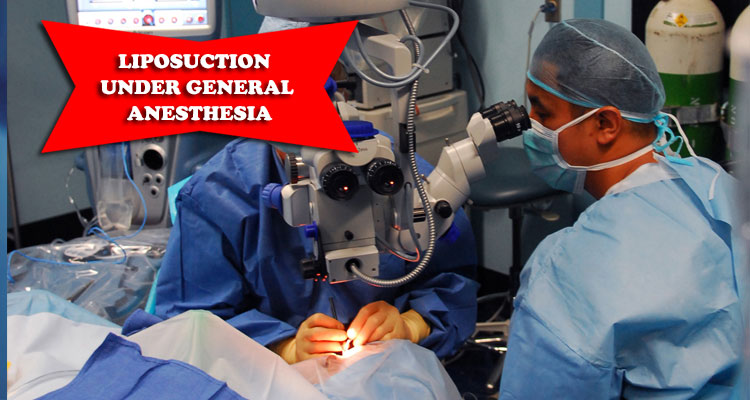
Benefits of general anesthesia
You do not feel or hear anything! If you prefer to sleep for your liposuction, general anesthesia is a clear choice.
More areas of the body can be treated in one surgery – if you want “full body” liposuction (4+ areas) to be performed in one way, you will need general anesthesia.
Disadvantages of general anesthesia
There are always some potential risks and complications associated with general anesthesia
Recovery from general anesthesia takes time, and the usual side effects will be drowsiness and nausea immediately after surgery.
It is more expensive! Having an anesthesiologist with the cost of a surgery center means a big price difference.
Surgeons often use larger cannulas in cases of general anesthesia. This requires larger incisions, and these larger cannulas have the potential to cause more bleeding and bruising, which can lengthen the recovery time.
When to choose local or general anesthesia for liposuction
Some surgeons may insist that general anesthesia is the only way – this is simply not true. If you just want to have a suction area, such as your chin or arms, your surgeon may recommend local anesthesia.
For smaller cases and smaller areas (such as the chin), general anesthesia is simply not necessary and should not be used.
However, general anesthesia may be preferred if you want to perform a lot of areas. Suctioning more than three areas in one procedure may not be possible using local anesthesia – it all depends on the size of your case and the areas you are treating.
In general, it is a decision that depends on personal preferences. If you want to sleep for the whole operation, use general anesthesia!
If general anesthesia sounds scary and you prefer to stay awake (with a mild oral sedative), liposuction under local anesthesia is probably a good choice for you.



